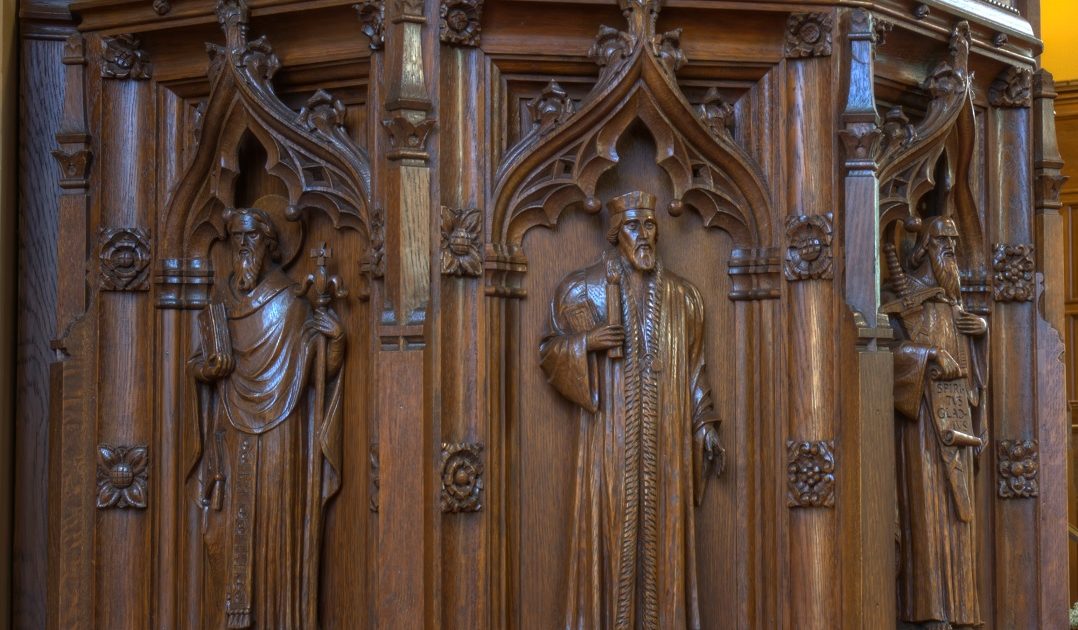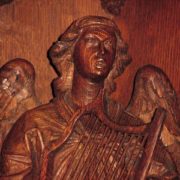
.
Wood Carvings at St. Paul’s
.
.
First, some definitions – Nave: The main area of the church, where the congregation sits. Chancel: The area behind the rood screen (see below) where the choir and clergy sit. Sanctuary: The area inside the altar rails.

We start our tour of St. Paul’s with the large, wooden Rood Screen at the entrance to the chancel. The word “rood” means “cross”, so we see that the Rood Screen is surmounted by a cross. The four extremities of the cross have symbols of the four gospel writers: Matthew, Mark, Luke and John. Matthew is represented by a man because his gospel stresses the humanity of Jesus; Mark is represented by a lion, the king of beasts or the royalty of Jesus; Luke by an ox, representing sacrifice or the priesthood of Jesus; and John by an eagle- the bird. that flies highest in the heavens – representing the divinity of Jesus.
Below the cross in the triangular part is the Agnus Dei (Lamb of God) representing Jesus, with a ladder on the left, which was used to take Jesus down from the cross, and on the right, a sponge on the end of a rod which was used to give him vinegar to drink. The rood screen is a memorial to those who served in the armed forces during World War I and has symbols of the Allied Nations of that war, together with the Army and Navy and two important battles of the war. Reading the shields from left to right one sees the Army seal, Portugal, Great Britain, Belgium, the United States, St. Mihiel in France, the site of an important battle, Chateau Thierry, site of another battle, France, Italy, Serbia, Russia, and the Navy seal.
On the rear of the screen are depicted the spear that pierced Jesus’ side, the nails used to nail him to the cross, and file symbol of Alpha and Omega, the first and last letters of the Greek alphabet, representing the beginning and the end.
To the left of the rood screen is the Pulpit, with carvings of four great preachers of the Church. Starting at the extreme left of the figures is St. John Chrysostom, Patriarch of Constantinople (d. 407), who has been credited with the Morning Prayer collect – “where two or three are gathered together.” To his right is Bishop Hugh Latimer (d. 1555), who was burned at the stake with Bishop Ridley during the reign of Queen Mary. He carries a candle because it is reported that Bishop Latimer said, as they were being burned, “We shall this day light such a candle by God’s grace in England as shall never be put out.” On the front of the pulpit is St. Paul, the great preacher and missionary of the apostolic age, and patron saint of this church (d. 64). To the right, then, is Phillips Brooks (d. 1893), who was rector of Trinity Church, Boston and Bishop of Massachusetts. He wrote the Christmas carol, “0 little town of Bethlehem.”
On the front of the desk of the pulpit are symbols of the Holy Trinity. From left to right: a crucifix represents the Son, the Father sits on the throne holding the orb, and the Holy Spirit is represented by a dove.
To the right is the Lectern, which also has symbols of the Trinity on the desk part. Here we start with the Holy Spirit, represented by a dove; the Son, represented by a lamb on a book with seven seals; signifying the seven churches of the Book of Revelation; and the Father, represented by the hand of God. Below the desk are figures, of the four Evangelists or Gospel writers.
The rood screen at the entrance to St. Mary’s Chapel (to the right of the lectern) is a memorial to The Reverend Roberts Seilhamer, who served St. Paul’s as curate and then rector for over twenty- five years (1914-1941). The chapel contains the altar from the original church (1816-1901) which stood about where the chapel is now, but facing Church Street, now the driveway. The window behind the altar is from the original church, and the paneling is made from the doors of the pews. The chandelier was given by Mrs. Samuel Slater in memory of her husband, who was the first Senior Warden of the parish.
Moving into the chancel, we see the carvings on the choir stalls as follows:
ALTAR END
St. Gregory Torch Bearers Choir Boy Celebrant Easter St. Cecilia
Moses Strings Crucifer Deacon Cymbals Laudate Dominum
O Come All Holy Night Thurifer Sub-deacon Jubal Cain Trumpets
Ye Faithful
These carvings represent those who take part in the liturgies of the church, together with some of the important things that take place during those liturgies. We find the celebrant at the Eucharist, along with those who assist. St. Gregory represents Gregorian Chant, St. Cecilia is the patron saint of musicians, and Jubal Cain is reported in Scripture to be the first bell maker.
On the front of the choir screens are symbols of the great canticles and other important parts of the Daily Office, especially Morning and Evening Prayer. Reading from the chancel steps toward the altar rail –
On the left we find:
The Pater Noster (Our Father)
The Venite (Psalm 95)
The Benedictus (The Song of Zechariah: Luke 1:68–79)
Gloria in Excelsis (Luke 2:14)
Cantate Domino (Psalm 149)
Deus Misereatur (Psalm 67)
Nunc Dimittis (The Song of Simeon: Luke 2:29–32)
On the right, moving back to the chancel steps, we find:
Benedic anima mea (Psalm 103)
Bonum est confiteri (Psalm 92)
Magnificat (The Song of Mary: Luke 1:46–55)
Jubilate Deo (Psalm 100)
Benedicite (Psalm 148)
Te deum laudamus (Hymn of Praise suggestive of the Apostles’ Creed)
Benedictus es domine (Song of the Three Young Men, verses 29-34)
On the altar rail we again find a variety of symbols, including the four evangelists. Reading from the left: St. Matthew, the cock that crowed as St. Peter denied the Lord, a bunch of grapes, and St. Mark. The gates have a chalice and the letters IHS, the first three letters of Jesus’ name. They continue St. Luke, a sheaf of wheat, a crucifix with Alpha and Omega, and St. John. On the East (altar) Wall to the left of the altar is the Scotch Thistle, and on the right, the English Rose.
Set into the East Wall, with. a sanctuary light burning at all times, is the aumbry, the place in which the Reserved Sacrament is kept for the communion of the sick and as a focus of devotion. The door of the aumbry has a carving of Christ at the Last Supper.
The kneeling desks in the sanctuary (the area inside the altar rail) have symbols of St. Paul on the front. The back of the Bishop’s chair set into the north wall of the sanctuary has the seal of the Diocese of Rhode Island. You will find a cross in the form of an anchor, with a mitre (bishop’s hat).
THE STAINED GLASS WINDOW over the altar is a memorial to those who served in the Second World War. In the quatrefoils near the top of the window are found a kneeling soldier on one side and a sailor on the other. The center of the window has Christ in triumph in priestly vestments. Below him are the beloved disciples. The scenes on either side of the center are from the life of St. Paul Starting on the left at the bottom is Paul’s conversion on the road to Damascus, then receiving his sight at the hands of Ananias, then being questioned by King Herod Agrippa. To the right Paul is shown preaching at Ephesus, preaching in Greece, then being martyred in Rome.
